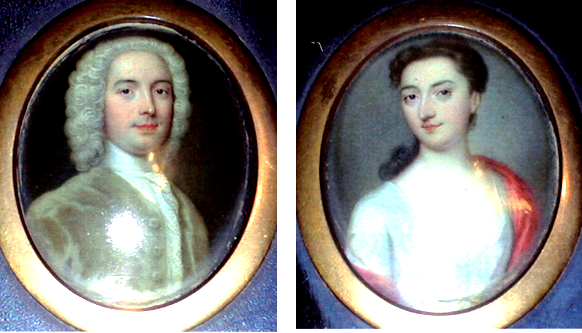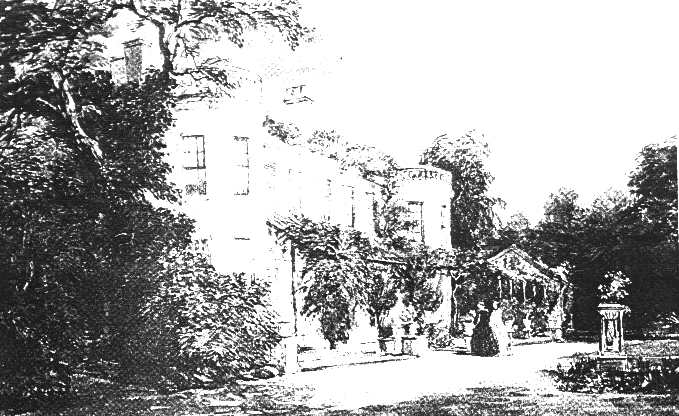Navigation: Hankeys of Churton > John Hankey > Robert Hankey > Robert Hanky > Thomas Hankey > Henry Hankey >
Sir Thomas Hankey (1704-1770)

Sir Thomas Hankey and Lady (Sarah) Hankey
By C.F.Zinke c.1733
(the year of their marriage)
Thomas Hankey, third surviving son of Sir Henry Hankey and Anne nee Chaplin, was born on 21 Dec 1704, probably at Fenchurch Street, and was baptised on 4 Jan 1705 at St Dionis Backchurch.
His mother died in 1709 when he was only five, and he must then have been under the care of Elizabeth Hankey, his mother’s aunt and the widow of Capt Samuel Hankey.
From the age of eight Thomas was educated at Merchant Taylors’ School, St Laurence Pountney, which was said to be cramped, noisy and ill-disciplined. He remained there from 1713 to 1716, and leaving school at the age of twelve, may have completed his education with a tutor. He was working at the bank by 1722, when he witnessed his father’s signature on a draft. He was admitted as a member of the Haberdashers Company on 25 Oct 1728, the year in which his father was Master.
The Hankeys continued to consolidate their wealth and influence by making a series of advantageous marriages.
vHenry Hankey himself had married the daughter of a wealthy wine merchant, whose estates in Suffolk he inherited in 1728.
vJoseph was married in 1723 to the daughter of Sir Henry Johnson, owner of a large shipyard not far down the Thames at Blackwall.
vThomas Hankey was married on 19 Jun 1733 at Clapham to Sarah Barnard (1710-62), elder daughter of the celebrated Sir John Barnard, MP.
Henry Hankey’s public services had been rewarded only six months earlier with a knighthood, which he received on the same day as his friend Sir John Barnard.
Henry Hankey’s bank, at the Ring and Ball in Fenchurch Street, continued to prosper, and both Joseph and Thomas were trained to follow in their father’s footsteps. Joseph and Thomas Hankey had become partners by 1732, when the firm was known as Sir Henry Hankey & Sons.
Following the death of Sir Henry in January 1737, honours quickly followed. Joseph Hankey, already an alderman, was master of the Haberdashers in 1737 and was knighted in August of that year; Thomas Hankey, a commissioner of lieutenancy for the City of London, was Master of the Haberdashers in 1745 and was knighted on 9 Sep of that year. ‘Sir Thomas was a leading man amongst the Grand Jury men of the County of Middlesex’.
Several of the next generation of Hankeys joined the bank in the 1760s - Sir Joseph’s son Joseph Chaplin Hankey and Sir Thomas’s three sons, Thomas, John and Robert. By 1765 the sign of the house was the Three Golden Balls, in Fenchurch Street.
In the middle of the eighteenth century, the firm was also actively trading in the West Indies, and records from Spanish Town, then the capital of Jamaica, show three mortgages in the name of Hankey dated 1754.
Over a period of more than fifty years the Hankeys had become close friends with Peter Simond, a Huguenot of Dutch origin, and were engaged with him in joint enterprises for West Indian trade. Peter Simond had no heir to take over his business, and it was agreed in 1764 that John Hankey, the second of Sir Thomas’s three sons, should go into partnership with Peter Simond and merge the West Indian side of the Hankey firm, and that on Peter Simond’s death his business should pass to the Hankey family.
The Hankeys were part of an influential and closely connected group of City dignitaries. Sir Thomas was son of Sir Henry Hankey (Alderman 1728-37 and Sheriff 1732); brother of Sir Joseph Hankey (Alderman 1737-69); and brother in law of Sir James Creed MP (a director of the East India Company).
His wife Sarah was related in varying degrees to no less than five former Lord Mayors:
- 1679 - Sir Robert Clayton MP, her first cousin three times removed;
- 1688 - Sir John Chapman, her 3x great uncle;
- 1717 - Sir William Lewen, her aunt’s uncle by marriage;
- 1737 - Sir John Barnard MP, her father;
- 1741 - Sir Robert Godschall MP, her uncle.
Thomas and Sarah had four sons and five daughters, of whom the following survived:
Jane Hankey (1734-1781)
Born on 11 Apr 1734 and baptised on 21 Apr at St Dionis Backchurch. Married Thomas Sutton of Moulsey (1727-89), by whom she had two sons:
-Admiral Sir John Sutton KCB, who in 1797 married his first cousin Hon Frances Hotham;
-Thomas (Tom) Sutton of Moulsey, created a baronet in 1806. As a boy he was ‘of quizzing notoriety’.
Thomas Sutton purchased the manor of East Moulsey together with his brother in law Beaumont Hotham. He was High Sheriff of Surrey in 1789.
Susannah Hankey (1737-1799)
Born on 12 Nov 1737 and baptised on 24 Nov at St Dionis Backchurch. She was married on 2 May 1759 at East Moulsey to James Norman of Broad Street and Moulsey (d 1764); the officiating minister was her first cousin Rev Harry Hankey, Rector of East Bergholt. James Norman was the proprietor of a gunpowder mill at East Moulsey, which had suffered a serious explosion in 1754.
Susannah was married secondly on 6 June 1767 at St Clement Danes to Beaumont, later second Lord Hotham (1737-1814), of Hampton. By him she had four sons (including Vice-Admiral Sir Henry Hotham, KCB, 1777-1833 see DNB) and three daughters (including Frances, d 1859, who married her first cousin Admiral Sir John Sutton). Susannah died on 1 Aug 1799. One of their descendants is the present Duchess of Cornwall.
Anne Hankey (1739-1778)
Born on 1 May 1739 and baptised on 31 May at St Dionis Backchurch. Anne, of Clapham, was married on 7 Apr 1761 to John Cholmley of the parish of St George, Hanover Square. They were married by Rev Harry Hankey, and the witnesses were Thomas Hankey and Mary Cholmley. Anne died on 7 Dec 1778, aged 39.
Thomas (Tom) Hankey (1740-1793)

Sir Thomas Hankeys house in Clapham
(this picture from the 19th century)
Thomas Hankey was brought up largely at Fenchurch Street, and possibly (from 1716 when he left Merchant Taylors’ School) at Clapham. When Thomas was married at his wife’s home village of Clapham in 1733, he soon decided to bring up his own family in the agreeable surroundings of that rural community, where one of the large country houses was occupied by Sarah Hankey’s father Sir John Barnard. Sir Thomas (as he then was) was certainly living at Clapham in about 1745, when a manuscript plan indicates his house; this was an attractive mansion with large grounds on Clapham Common Southside, in the vicinity of the present Elms Road. The City was five miles distant, and Sir Thomas no doubt made the journey by coach, remaining overnight at Fenchurch Street if necessary. He evidently retained a town house, as a Poll of 1749 gives his address as Lime Street (leading off Fenchurch Street); and he later apparently had a town house at Bedford Square, where he died.
Rural though Clapham was, it had its share of serious crime, and ‘in February 1751, Sir Thomas Hankey and his Lady were the victims of a Highwayman on the Common, who later in the day was captured by a shooting party at Vauxhall, whilst making another attempt’. It was also necessary to protect the Bank against possible riot, and the racks of muskets which were known to line its walls in the early nineteenth century were probably already there in Sir Thomas’s time.
The Hankeys continued to use St Dionis Backchurch throughout the eighteenth century, but they must have attended church at Clapham when resident there, and Sir Thomas was evidently a member of the Vestry. Sir Thomas Hankey’s interest in public affairs was by no means confined to the City, as the following examples show:
-In 1757 Vauxhall Bridge was ordered to be widened and repaired; the estimate was £85, but Sir Thomas offered to undertake the work for 20 guineas, which was paid to him in 1760.
-The Victoria & Albert Museum has a silver communion set, London 1763-4 (designed by Abraham Portal, who was apprenticed to Paul de Lamerie) which was ‘formerly the property of the Asylum for Female Orphans, opened in Vauxhall in 1758, to which it was presented by Sir Thomas Hankey, a leading London banker and philanthropist. His crest and arms are engraved on each piece with a donative inscription’ – ‘The Gift of Sir Thomas Hankey, Knight, to the Chapel of the Asylum 1764’.
- In 1765 the Clapham parish fire engine and leather buckets had been repaired at a price of £42 6s. The bill was presented to the Vestry and Sir Thomas Hankey being present was ‘requested to pay the said bill if Mr Brookes can’t stay for the money till the next Poor Rate be made and money in hand to pay it.’
Sir Thomas was life tenant of substantial property under his father’s will; his own will (made on 20 Apr 1769 and proved with a codicil on 17 Jul 1770 at London, by his son Thomas Hankey as sole executor) mentions property purchased by him at Bramford, near East Bergholt and at Clapham. His lawyer was Samuel Troughton the younger.
Lady Sarah died on 15 Mar 1762 and was buried on 22 Mar at St Dionis Backchurch.
Sir Thomas Hankey, the great Banker, died on 3 Jul 1770 at Bedford Square and was buried on 10 Jul in the family vault at St Dionis Backchurch.